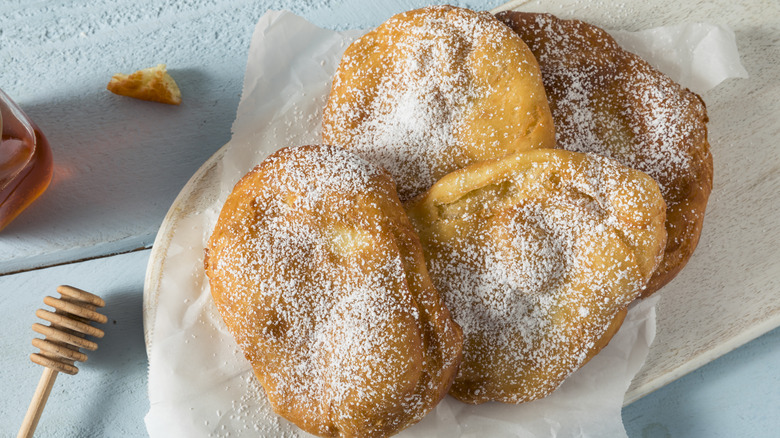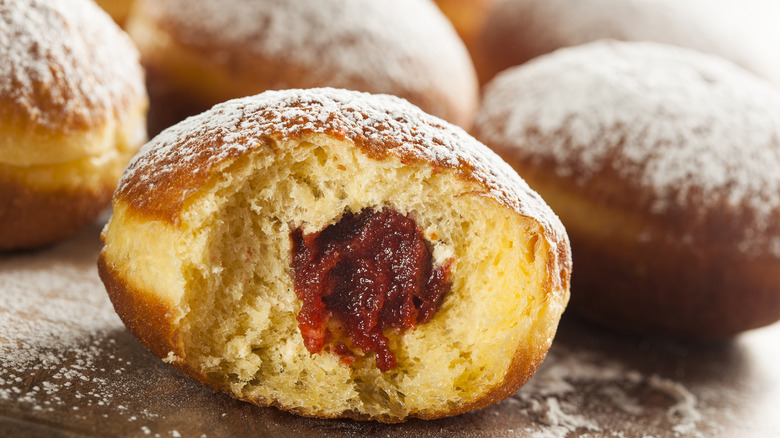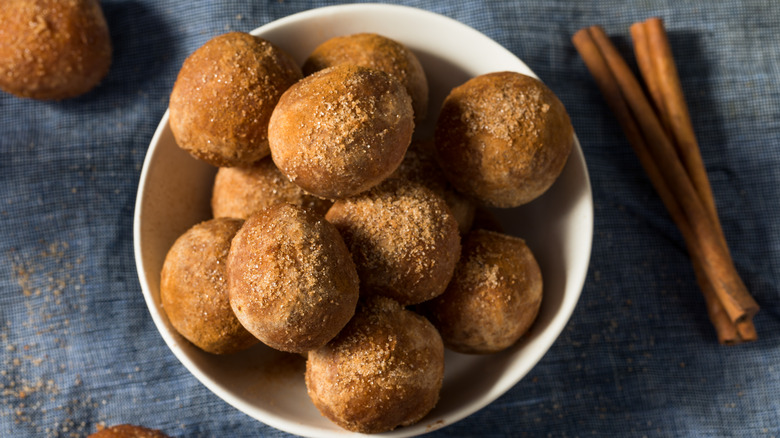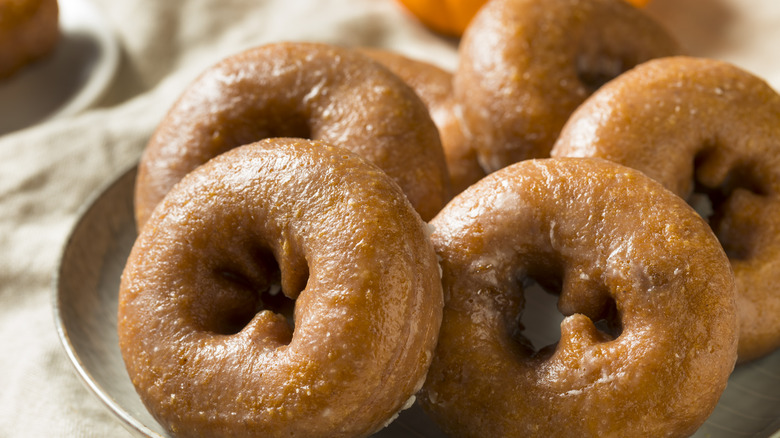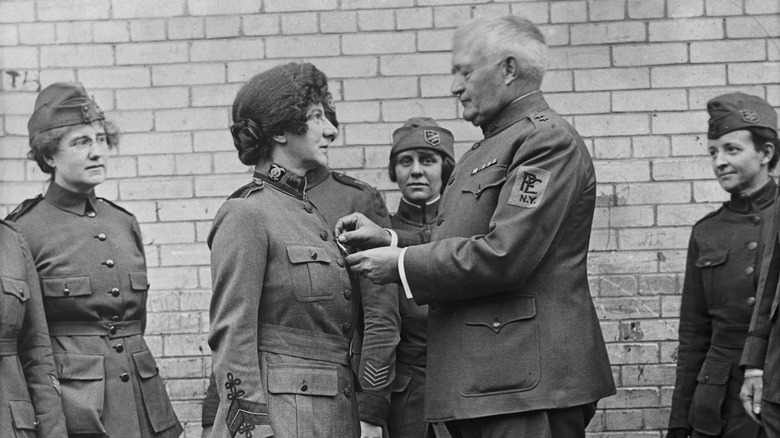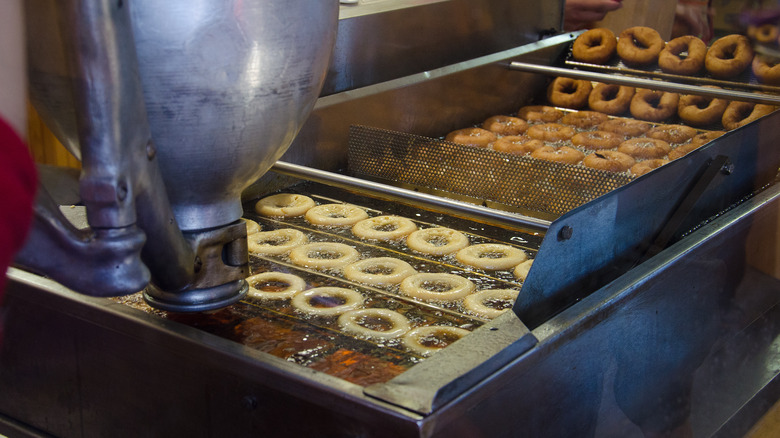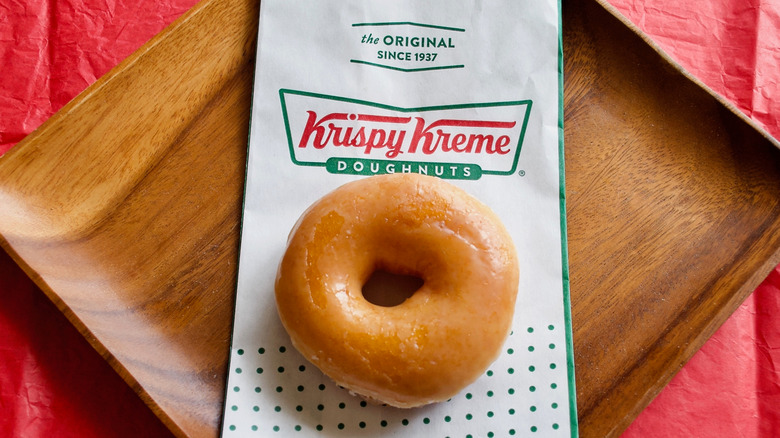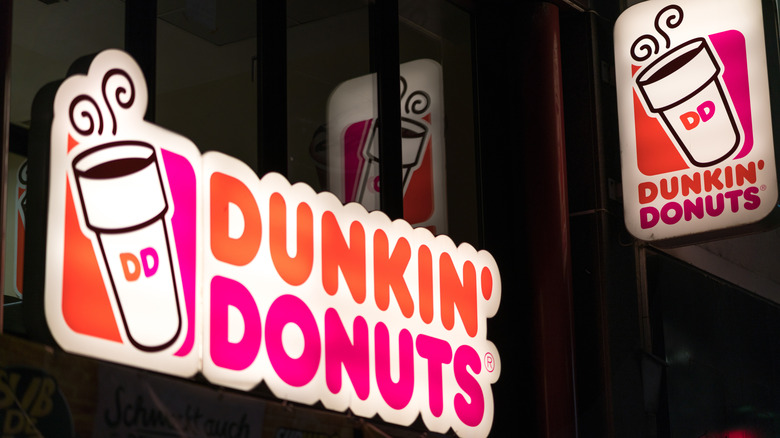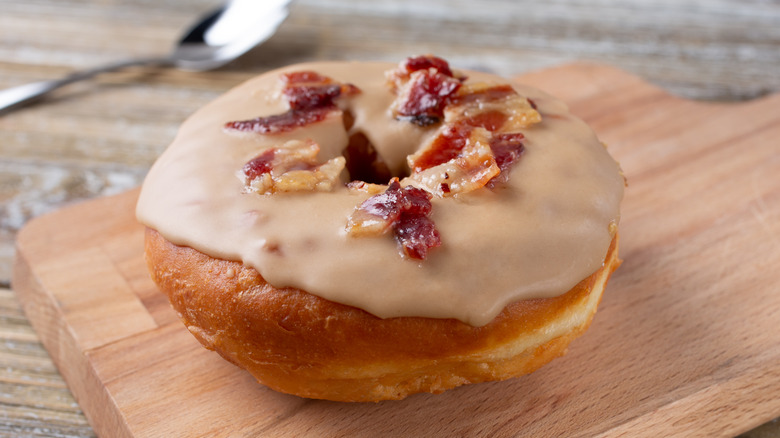The Mouthwatering History Of Donuts
In 2017, a survey performed by National Today in collaboration with Postmates found that 91% of Americans like donuts. That's an incredibly high proportion, especially for a country whose culinary scene varies so drastically by region. The report got us thinking more deeply about the United States' favorite breakfast pastry. We know that donuts are not a new invention and that their roots trace back at least to the early days of American colonization, but we can't quite imagine our pilgrim forefathers sitting down for breakfast and biting into a chocolate and sprinkle-covered donut.
So how did the donut evolve? Where did it come from and how did it take on its modern-day form? When did donuts transition from being simple easy-to-make pastries to elaborate concoctions filled with experimental flavors and textures? From donuts' prehistoric origins to current-day trends, we've included everything you need to know about the gloriously sugary rings.
The ancient origins of donuts
Evidence suggests that as far back as 6,000 years ago, Ancient Egyptians were frying leavened dough in oil to make cake-like snacks that were eaten by Pharaohs and other wealthy folks (via The Byzantine Ambassador). Centuries later, Greek and Roman chefs added honey to these cakes, bringing the sweetness factor to a whole new level.
Ancient Greeks passed out these "honey tokens" to Olympic champions as part of their prizes. Romans commonly ate similar honey-sweetened "dulcia" at all of their festivals. In fact, the treats were so popular that Cato the Elder, one of humanity's first written historians, recorded a recipe for honey cakes in his work "De Agri Cultura." While these ancient pastries wouldn't have been exactly like the donuts we know today, many food historians argue that they certainly count as precursors.
In a deep dive into the history of donuts, the Smithsonian Magazine reports that Ancient Egyptians, Greeks, and Romans weren't the only ones eating donut-like pastries either. Archeologists have found fossilized bits of donut-adjacent foods in prehistoric Native American settlements. It seems that no matter where you look across the globe, people have been trying to master the perfect donut recipe for thousands of years.
Gefüllte Krapfen
Understandably, given the sheer number of predecessors out there, there are many opinions about where, when, and how modern-day donuts evolved. One thing most folks can agree on, however, is that the first written recipe for modern-day donuts was included in a popular 15th-century German cookbook called "Kuchenmeisterei" (via Time).
Known as gefüllte Krapfen, the donuts were made of a yeast dough, filled with jelly, and deep fried in lard. Given how prohibitively expensive sugar was, many folks adapted the recipe, filling the unsweetened dough with savory ingredients like meat or mushrooms (via University of Southern California). This twist on the classic recipe sounds like something you might find in a boutique donut shop today.
Not long after the gefüllte Krapfen recipe was printed, Jewish food historian Gil Marks reports that many European Jewish communities began making these jelly-filled treats for Hanukkah (via Atlanta Jewish Times). Previously, they'd remembered the miracle of the oil by frying pancake-style fritters but soon swapped out that particular tradition for more celebratory donuts. A holiday staple to this day, these treats are called sufganiyah in Hebrew.
Olykoek
Donuts finally arrived in North America in the early 17th century when Dutch settlers brought olykoeks to New Amsterdam (via University of Southern California). A Dutch cookbook called "The Sensible Cook" showcased a recipe for olykoeks made with typical donut ingredients — milk, eggs, yeast, flour — then rolled into balls and fried in pots of hot oil.
The problem, home chefs quickly realized, was that the outside of the olykoeks would burn before the inside had cooked all the way through. To fix this, folks began filling the center with something that didn't need cooking to be consumed, like apples, nuts, or dried fruits. Many etymologists believe that it was the nuts used to fill the center of olykoeks that gave donuts their English name.
Of course, other people dispute this and suggest the shape of the pastry (similar to a knot) led to the development of the word donut. Whatever the case may be, by the end of the Revolutionary War the word donut was widely used and the sweet treats began to be regarded as distinctly American. How do we know this? Washington Irving's "History of New York" from the early 1800s includes references the food and uses the term dough nut rather than olykoek for the first time (via Thrillist).
A holey development
For almost half a century, bakers continued to make donuts in their original round shape. It wasn't until sometime in the mid-1800s that a center hole came to be. According to The New England Historical Society, a ship captain, Hansen Gregory, came up with the idea. He shared the story of his culinary breakthrough, noting that the exterior tended to get very crispy while the twists in the dough soaked up oil, making it a pretty heavy treat. So he had the bright idea to chop a hole straight through the middle, hoping they would cook more evenly.
According to Gregory, he first used the lid of a pepper can to cut the holes but eventually had a special donut cutter fashioned out of tin. On a visit home, he shared the trick with his mother, who then shared it with her entire community. From there the exact details are murky, but we'd have to imagine that the innovation caught on pretty quickly, because by 1877 cookbooks were calling for donuts to be shaped into rings for expeditious cooking (via Food Timeline).
Donut Lassies
Up until this point, most of the development of donuts has been confined to the northern United States. That's not an error in reporting on our part; prior to WWI, donuts were more of a northern treat simply due to the fact that the immigrants who brought the recipes to America largely settled in the New England area. However, following WWI and the service of Donut Lassies, the sweet treats rose in popularity and were enjoyed across the country.
Smithsonian Magazine explains that Donut Lassies were a group of Salvation Army volunteers (primarily women) tasked with providing moral support for soldiers stationed in France. Their contributions included things like religious services and live music, as well as sweet treats to remind the men of home. Donuts quickly became their chief dessert offering as they were quick and easy to make. Additionally, they didn't require a lengthy list of ingredients or an oven which would have been hard to obtain in war-torn zones.
By the time they returned home, many veterans had acquired a taste for donuts and were anxious to get their hands on the nostalgic food. As a result, women all across the U.S. began making them at home and selling them in bakeries. Today, National Donut Day is observed in honor of the work the Donut Lassies did back in WWI.
An automated future
America's post-WWI obsession with donuts was assisted by Adolph Levitt. During the war, Levitt fled czarist Russia and came to America in search of opportunity, which he found in the donut business.
Up to this point, donuts were made completely by hand. From the mixing to the cutting to the frying, each ring was prepared individually. And while donuts weren't hard to make (at least, in comparison to other popular desserts) the process was still quite time-consuming. Realizing the original method was a problem for bakers looking to make a profit, Levitt set out to create a machine that could make multiple donuts at once and didn't require the undivided attention of a pastry chef (via Logically).
In 1920, Levitt introduced the Wonderful Almost Human Automatic Donut Machine. He placed the machine in the window of his Harlem bakery, and it became an overnight hit with neighborhood folks. Its popularity quickly spread and copycat machines began popping up in bakeries all over the country. Levitt's invention revolutionized the food industry to the extent that it was even included in the 1934 Chicago World's Fair, where donuts were the focus.
The National Dunking Assosciation
The Wonderful Almost Human Automatic Donut Machine wasn't the only way Adolph Levitt revolutionized the donut industry. The NYC baker turned his invention and his small Harlem business into a national company called the Donut Corporation of America (via The New York Times).
The business had two functions. One arm of it manufactured Levitt's machines and put together pre-made donut mix that could be used by bakers unwilling or unable to make their own. The other arm of the company focused on spreading the gospel of the donut. It was this branch of the company that started the National Dunking Association.
The association's main goal was to encourage Americans to eat more donuts. First, it ran a very successful campaign called "Dunk It!", which encouraged folks to dunk the treats in their morning coffee, tea, or milk (via Ian Brabner, Rare Americana). Before this bit of marketing ran, donuts were typically eaten as a post-meal dessert rather than as a full meal.
The National Dunking Association also ran farcical crusades like the "Donut vs. Cruller" episode, which attempted to make the FDA draw a distinction between donuts and other pastries (via The New York Times). The real objective here wasn't to establish a dictionary definition but to get folks to eat more donuts so they could decide for themselves.
Krispy Kreme changes the game
Right around the time that Adolph Levitt was developing his automated donut machine, a man named Vernon Rudolph was launching his own donut empire in Winston-Salem, North Carolina. As an entrepreneur, Rudolph had purchased a yeast doughnut recipe from a French chef in New Orleans back in 1933 (via North Carolina Museum of History). After tinkering and testing it out at his uncle's general store in Kentucky, he opened his own donut shop named Krispy Kreme in 1937. The smell of Rudolph's freshly made donuts proved so enticing that he wound up cutting a service window in the wall to serve customers more efficiently.
After franchising the brand name out to other small family-owned companies, Krispy Kreme began sending dry mix and equipment to its partners in the 1950s. This ensured the donuts would be consistent no matter where you bought them. Today, the first donut chain has over 700 stores in nearly a dozen countries (via Krispy Kreme). Almost 100 years later, it remains one of the most popular donut franchises in the world.
Doughnut vs. donut
As with many English words, it's unlikely that we'll ever be able to fully trace the origins or exact reference point of the development of the term donut. However, the transition of the spelling from doughnut to donut is much more readily agreed upon.
When Washington Irving first mentioned donuts back in 1809 he wrote it as a self-explanatory two-word phrase: dough nut. Etymology Online reports that by 1870 there were already recorded instances of its abbreviated spelling (donut), and folks were using the spellings interchangeably. Mental Floss comments that the spelling didn't achieve mainstream popularity until the 1950s when Dunkin' Donuts opened its first location.
So which spelling should you use? Opinion is split. Merriam-Webster correctly points out that donut is usually listed as an alternative spelling to doughnut. Nevertheless, both are an accepted part of the common vernacular, so you're free to use whichever strikes your fancy.
A slam dunk
In 1948, William Rosenberg opened a small shop in Quincy, Massachusetts, called Open Kettle (via Dunkin' Donuts). He sold five-cent donuts and ten-cent cups of coffee from the roadside stand for two years before rebranding it as Dunkin' Donuts (perhaps inspired by the National Dunking Association's "Dunk It!" campaign). Following the rebrand, the restaurant was considerably more successful, and by 1955 it was opening additional franchised locations.
Within 10 years, Dunkin' Donuts had over 100 locations in the United States and began looking at ways to expand its offerings. In 1973, the restaurant added its world-famous Munchkins to the menu, a perennially popular favorite that's now included in more than 1 billion sales each year, per the company website.
According to the corporation, there are now 12,500 Dunkin' Donuts across 46 countries. The chain sells over 2.9 billion donuts annually, making it one of the biggest donut retailers in the world. Not a bad outcome for a lonely, one-man stand!
A sweet love affair
America's obsession with donuts has only grown since Dunkin' stepped onto the scene. According to USA Today, there are now an estimated 13,000 donut shops in the U.S. alone. Kind of wild when you recall that the country's first donut stand was opened just 350 years ago (via Thrillist). While that innovative Brooklyn stand established NYC as the donut capital of North America, that honor now lies with Boston, which has one donut shop for every 2,400 residents.
Of course, donuts have changed quite a bit since they were first developed. Gone are the days when simple cake or yeast donuts were your only options and berries and nuts were the only fillings. Now you can get donuts glazed and stuffed with everything from pink icing to jalapeños to edible flowers to bacon.
Those unique flavors might keep the donut scene interesting, but they haven't yet captured the hearts of Americans as the classic flavors have. According to data compiled by Ipsos in 2021, cream-filled donuts are still the most popular flavor, followed by plain-glazed, chocolate-glazed, and old-fashioned donuts. So maybe some things haven't changed that much after all.

